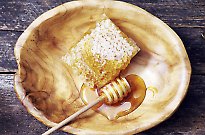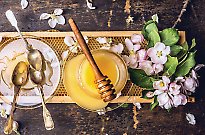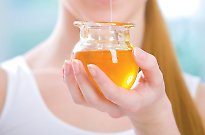
Health benefits of honey

Whether eaten or used topically, honey's long list of health benefits earns it its place in the pantry.
Angela Tufvesson looks at the topical and edible health benefits of honey
Did you know that honey has been used and consumed throughout recorded history for over 4000 years? The ancient Greeks, Egyptians, Chinese and Romans employed honey in the treatment of wounds and intestinal disorders. An ancient Egyptian text prescribes a mix of grease, honey and vegetable fibre as a standard wound treatment. The Roman scientist Pliny combined honey with the fat of fish to treat wounds. It really is an ancient remedy.
Made by honeybees drinking nectar from flowers and stored in wax honeycombs, the honey that lines our supermarket shelves in neat jars isn't far removed from the liquid gold favoured by ancient civilisations, albeit with slightly more processing.
And modern science is showing our ancestors we're on the right track – the topical and edible health benefits of honey are many. Honey has been shown to be effective in the treatment of ulcers, burns, skin wounds and as an anti-inflammatory to relieve pain. Plus, your mum was right – it's a sound cough remedy.
HEAL THE WOUND
Applying honey preparations directly to wounds or using dressings containing honey improves healing, say scientists. Honey helps reduce infection and pain, clean wounds and decrease healing time.
“Honey is used widely for a variety of skin complaints like acne, eczema, psoriasis, wounds and burns,” says naturopath Jules Galloway from Let Go and Live, an online health and detox program.
One University of Sydney study found that some honeys could be more effective than antibiotics in treating surface wounds and infections. Most infection-causing bacteria in hospitals are resistant to at least one antibiotic, but researchers found that Manuka and jelly bush varieties of honey worked on all the infectious bugs tested.
“Our research is the first to clearly show that these honey-based products could in many cases replace antibiotic creams on wounds and equipment such as catheters,” says Associate Professor Dee Carter. “Using honey as an intermediate treatment could also prolong the life of antibiotics.”
So how do the contents of Pooh Bear's pot achieve such success? “Honey has antibacterial and antimicrobial effects due to the hydrogen peroxide activity, and it also forms a barrier to prevent bacteria from entering the wound,” says Galloway.
In ancient times there was no knowledge of bacteria, but we now know that festering wounds are the result of infection by microorganisms – and honey is an antimicrobial substance…it kills germs. The hydrogen peroxide it releases is similar to germ-killing bleach, except that it stays active for several days, killing bugs and preventing others growing.
And because honey contains a high concentration of sugars – glucose and fructose – it attracts water, meaning there's little water available in the wound for the growth of microorganisms. Who knew sugar could have such a positive effect?
ON THE INSIDE
Honey's appeal is broader than just skin conditions – in its edible form honey helps reduce inflammation and the risk of illness.
“Honey has immune boosting and soothing properties,” Galloway says. “It is used widely for a variety of conditions including throat infections, stomach ulcers and to help improve general immune function.”
Drinking tea with honey is a time-honoured and natural way to soothe a sore throat, not to mention a lot more pleasant than sucking on a cough lolly. Research has found it may also be an effective cough suppressant.
In a study published in the Archives of Paediatrics and Adolescent Medicine, children who received a small dose of buckwheat honey before bed coughed less than those who received a cough suppressant or nothing at all.
Galloway says locally sourced honey was traditionally used as a treatment for hay fever. “It was thought that consuming the honey made from local flowers somehow desensitised the hay fever sufferer to the local pollens.”
Mainstream medicine doesn't fully support this theory, just as there is insufficient evidence for several popular honey-based claims – namely that honey helps improve athletic performance, reduce the effects of sunburn and soothe symptoms of asthma. But with concerns about the over-prescribing of antibiotics on the rise, it's an area for ongoing research.
LEADER OF THE PACK
Unfortunately, harnessing the health benefits of honey is not as simple as a trip to the condiments aisle of the supermarket. Manuka honey – produced by bees drinking the nectar of the Manuka tree in New Zealand – is the big daddy of topical honey.
Experts have long recognised the value of Manuka honey as a superior treatment for wound infections. Australian Jelly Bush honey, from a similar plant species, has also been found to share the same properties, say researchers from the University of Waikato in New Zealand.
What makes Manuka and Jelly Bush more potent than other varieties of honey is the high level of additional non-peroxide, antibacterial components, which are stronger than typical hydrogen peroxide types of honey. And to make it even more difficult, due to marketing confusion and the make-up of the end product, only some honey sold as Manuka honey possesses this non-peroxide type of antibacterial activity.
“The strength of Manuka honey varies, and is often indicated by a UMF rating (unique Manuka factor),” says Galloway. “Other varieties have some antibacterial properties, but only Manuka honey has been scientifically tested and graded before making it into the jar. Some say that tea-tree honey may have similar levels of antibacterial action, but it is yet to undergo the same rigorous testing.”
If you'd prefer to chat to your chemist, standardised medical-grade honey is sold in limited quantities in pharmacies and is primarily used for wound care.
Discover more about which vitamins and minerals will boost your vitality and health. Follow us on Facebook and Twitter for natural health news every day.
Image credit: Thinkstock


